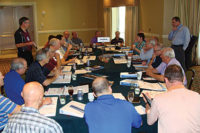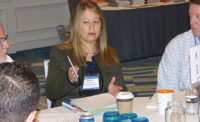While the setting for the 2018 ASA Winter Leadership Meeting on Paradise Island, Bahamas, lent itself to plenty of networking, fun and relaxation, just as much serious business was conducted related to the future of the PHCP-PVF national association and the industry in general.
More than 60 American Supply Association volunteer leaders assembled for two days of strategic planning aimed at taking a long-term course of action regarding a host of issues and concerns facing the industry. The theme of the meeting, “Building One Future,” centered on identifying what ASA members of 2027 will look like, the issues they will face through change coming at them at an exponential rate and how the association can be positioned to do what’s best for its members.
One of the most fascinating aspects of the meeting was facilitator Dirk Beveridge (longtime ASA contributor/speaker and Supply House Times columnist) presenting what he termed the characteristic spectrum of the ASA distribution member.
Beveridge, based on his research with ASA members, broke the spectrum into four categories: lifestyle, late adopter, early adopter and professional and entrepreneurial.
Lifestyle refers to a business with no legacy, no successorship and little market value, which is not bad if it’s premeditated, Beveridge noted. The late adopter is defined as a business with leaders who like to talk about change, technology and the future, yet are reluctant to act. There is internal struggle with desire for growth, improvement and innovation, yet being pulled back to yesterday.
The early adopter business, as Beveridge explained, is one with leaders who stand in line when the new iPhone comes out. Always with an eye on the future, they are driven to define their “next,” and insure the business is perpetually trying new things.
Finally, the progressive and entrepreneurial company shines as the clear market leader that is not bound by today, but is challenged by what is possible and is intent on organization legacy.
As the strategic planning meeting continued to unfold, the spectrum and where ASA companies fall on it became more of a central topic, particularly with the rapid and unrelenting amount of change constantly facing distributors.
“We need to develop the tools that allow a company to figure out who they are in an honest way,” Winsupply’s Steve Edwards said. “And then teach companies how to get from the left of the spectrum to the right if they desire to change. ASA can help identify where a company is at in the phase and point out the pitfalls and dangers and make them aware of the potential risks involved if they choose not move.”
“Companies have to identify where they are in the spectrum and then they need information that can help them change if they decide,” M. Cooper Winsupply’s Dave Poteete noted. “How can we support the companies who want to move forward?”
The Granite Group’s Bill Condron cautioned companies on the left-hand side of the spectrum may want to seriously consider the repercussions of standing pat in a day and age where innovation and adaptability are paramount.
“The train has already left the station,” he said. “We need to be prepared for this, now. How will our industry best prepare for what will be an extremely disruptive environment going forward?”
Condron’s suggestion is to tailor educational tools toward each component of the spectrum. “Take each spectrum and create specific tracks for them,” he said. “For instance, with a lifestyle company, help them with succession planning so they can move over on the spectrum if that’s what they are trying to achieve.”
Beveridge cited some staggering statistics from his recent research projects with distribution companies where 42% of companies he polled are too rooted in the past rather than innovating, while less than 10% are prepared for the future and 88% believe their organization is experiencing a disruption.
“Our biggest risk is not our business that we can control,” Bradford White’s Bruce Carnevale said. “Our biggest risk is what is happening in the distribution channel. A good majority of distribution businesses need to recognize there is a problem and need to see the changes that need to be made in order to compete in the marketplace.”
Tackling the tough issues
The meeting also was filled with productive conversations regarding hot-button issues that continue to swirl around the industry. Key issues identified include the continued topic of labor shortages and the importance of human capital, technology, customer expectations, political uncertainty, consolidation and the environmental component.
Beveridge conducted an impromptu poll of volunteer leaders on the last day and by more than a 3:1 margin, the biggest concern/issue to work toward a solution going forward continues to be attracting and retaining employees, followed in distant second by technology.
“We have to attract new talent,” former ASA President Scott Robertson of Robertson Supply said. “We have to come up with a better selling tool than we sell potties. We are going to lose an incredible amount of people who are getting older and retiring. We have to do a better job promoting our industry to young people.”
InSinkErator’s Rob Grim added: “The biggest issue right now is workforce development and getting people engaged and into the industry. We need to help them see the tremendous success they can achieve on a personal level in the industry.”
Coburn Supply’s Michael Maloney spoke about changing technology and the continued proliferation of new threats, particularly those of a web-based variety. “The barrier to entry is lower,” he said. “There is a rise of niche people on the web where they do one thing and they do it really well.”
Kohler’s Jim Lewis added: “Big e-tailers know everything about their customers. What do we know about our customers?”
Lewis said companies must innovate beyond their customers. “What are the unexpressed needs of the customer?” he asked. “And get to a point where the customer says, “How did I ever live without you?” Deliver something they cannot live without and continually address their needs.”
ASA in good shape
During the final-day ASA Board of Directors meeting, it was noted the association achieved net membership growth in 2017 for a sixth year in a row and has reinvested $141,000 out of its healthy reserves into the organization for initiatives such as the hiring of a full-time business intelligence individual and the rollout of the new Digital Branch e-commerce program.
There also was an extended discussion on the health and continued relevance of member regional organizations, a topic that will generate future discussions.
“We’ve had some success and now is the time to blow it out and have even greater success,” ASA CEO Mike Adelizzi told volunteer leaders at the end of the strategic planning session.
ASA’s NETWORK2018 takes place Oct. 31-Nov. 2 at the Fairmont Princess in Scottsdale, Arizona. The 2019 Winter Leadership Meeting heads to Coronado Island, California, Feb. 5-7.
This article was originally titled “Building one future” in the March 2018 print edition of Supply House Times.










